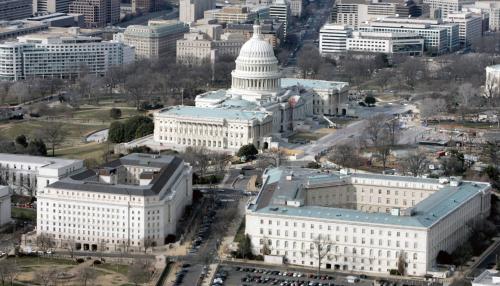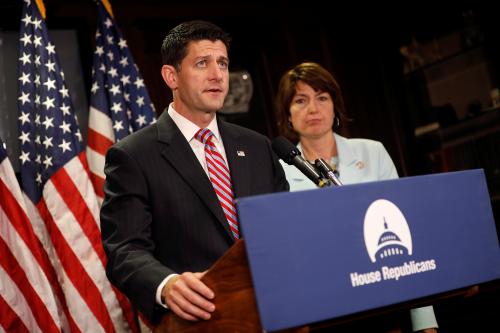With Senate Republicans working to meet their self-imposed target of the July 4 recess to pass a health care bill, most attention on Capitol Hill has been devoted to their work on a legislative response to the House-passed American Health Care Act. This focus has pushed to the background a set of issues on which Congress must deal with actual deadlines: the budget process.
Under the Congressional Budget Act of 1974 (CBA), the first step in the congressional budget process is the adoption of the annual budget resolution, which sets a broad framework for revenue and spending for the next fiscal year. The CBA sets an April 15 target for completing this task—a deadline with which Congress has repeatedly struggled. We might expect the process to get off to an especially late start in years when a new president has come into office, because Congress, especially one controlled by the same party as the White House, may want to wait to get some input on the executive’s budget priorities. It is worth noting, however, that the last two times a new president came into office—2001 and 2009—Congress completed its work on the budget resolution much more quickly than this, finishing working by early May and late April, respectively. This year, while the House may mark up its version before the recess, Congress will fall short of this benchmark.
Generally, we would expect Congress to be more successful at completing this task in periods of unified congressional control—that is, when the House and Senate are both controlled by the same party. Congress began considering a single budget resolution in 1982, and since then, it has failed to complete work on the measure in four of the 25 years that the same party controlled both chambers. In the ten years when one party has a majority in the House and the other in the Senate, by contrast, the budget resolution has gone unfinished five out of ten years.
Why has Congress left the budget resolution undone so far this year? First of all, the decision to use the leftover 2017 budget resolution to initiate the expedited budget reconciliation process for health care legislation has had implications for work on the 2018 budget resolution. At the start of the year, Republicans set out an ambitious, two-reconciliation-bills-in-one-year strategy, hoping to pass two major legislative initiatives through a process that avoids a Senate filibuster. In order to do that, however, congressional rules appear to require work to be completed on the first of these measures before the budget resolution initiating the second is adopted. While Congress could essentially complete all work on this year’s budget resolution and then hold it in the wings until the health care bill is finished—as they did in 2006—the incentive to devote time to the resolution may be less when members know that final passage is not imminent.
In addition, the persistent divides among House Republicans have slowed the process in that chamber. In particular, disagreements about defense spending, the proposed discretionary cuts in President Trump’s budget, and whether to use the reconciliation process to cut social programs like Temporary Assistance for Needy Families (TANF) and the Supplemental Nutrition Assistance Program (SNAP) in addition to for tax legislation have made reaching agreement on a resolution difficult.
While the budget resolution is meant to establish the framework for the annual appropriations process that funds discretionary federal programs—such as the military, scientific research, and K-12 education—Congress has options to start the latter without the former being finished. Last year marked the first time that the House simply began considering appropriations bills without any sort of formal process to establish high-level (top-line) budget numbers. It appears that the same will be true this year, with the House appropriations committee approving its first bill on June 15.
How do this year’s efforts stack up to the two most relevant recent comparison cases, 2001 and 2009? In 2001, there were four appropriations bills approved by the appropriations committee for floor consideration in the House before the July 4 recess; their Senate counterparts had prepared one. In 2009, meanwhile, the House panel had finished work on seven while the Senate committee had completed four. With no additional full committee markups in either chamber scheduled as of this writing between now and the recess in either chamber, Congress is set to leave town with substantially less work done than in other recent comparable years.
It is virtually certain that Congress will again need to turn to a continuing resolution, a single large omnibus spending bill, or some combination thereof to keep the government running come October 1—but the calendar is not the only thing to blame. A two-year agreement adopted in 2015 to relax the limits on discretionary spending imposed in 2011 expires this year, and a decision about whether and how to ease those caps again has not been made. Structural features of the chamber also suggest an omnibus is coming. As political scientist Peter Hanson has argued, the Senate has frequently combined multiple spending bills together when the chamber is polarized and the majority party’s margin of control is small.
Several ideas are reportedly under consideration in the House, including one bill combining various security-related programs or simply “going ugly early” and passing a single package covering everything in advance of the August recess. Doing so, say proponents, would “buy the leadership goodwill with the conference” by giving the House a chance to adopt a measure that reflects conservative Republican priorities even with the knowledge that it would fail in the Senate. It is unclear, however, if a symbolic move now would ease ultimate resolution of the issue later. Former Speaker John Boehner (R-Ohio) repeatedly gave his conference chances to vote on more extreme bills than the Senate would ultimately pass before bringing a final deal to his members, only to see frustration with him build over time.
In the background of these debates looms an additional challenge: the debt limit. Current projections put the date at which the federal government would not be able to meet its obligations sometime between September and November, but some in Congress—and the Treasury Department—have begun to discuss the possibility of a July vote on an increase to the limit, especially in the Senate. Whether and how the debt limit vote gets linked to other fiscal decisions, however, remains to be seen. Some members, particularly conservative House Republicans, may hope to keep the debt limit vote and a likely omnibus bill on the same schedule with the hopes of using the former to extract concessions on the latter. Given the need to bring eight Senate Democrats on board, however, it’s difficult to imagine that strategy working as Republicans would hope. Research suggests that members of the president’s party are usually willing to deliver the votes on a debt limit increase, but Republicans’ recent history on the issue might lead us to question whether we’ll see the same dynamic this year. Regardless of what specific approach Congress ultimately takes on these issues, however, they’ve left themselves with a lot of work to do and not much time to do it.
The Brookings Institution is committed to quality, independence, and impact.
We are supported by a diverse array of funders. In line with our values and policies, each Brookings publication represents the sole views of its author(s).








Commentary
While GOP resolves its differences on healthcare, budget deadlines loom
June 26, 2017